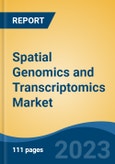Speak directly to the analyst to clarify any post sales queries you may have.
10% Free customizationThis report comes with 10% free customization, enabling you to add data that meets your specific business needs.
Key Market Drivers
Technological Advancements in Spatial Omics
The rapid technological progress in spatial omics is significantly advancing the spatial genomics and transcriptomics market. High-resolution sequencing and imaging technologies have enabled researchers to map gene expression with spatial precision, enhancing the ability to study biological complexity within tissue samples. Platforms such as the 10x Genomics Visium have exemplified this by merging high-resolution imaging with spatial gene expression data. These innovations have broadened applications across oncology, neuroscience, and developmental biology by supporting the identification of biomarkers, understanding cellular heterogeneity, and enabling the development of targeted treatments. The convergence of spatial data with proteomics and metabolomics continues to enrich biological insight and therapeutic strategies.Key Market Challenges
Regulatory Compliance and Validation Complexities
A key challenge for the spatial genomics and transcriptomics market lies in the complex and evolving landscape of regulatory compliance and validation. As these technologies integrate sequencing, imaging, and bioinformatics tools, they fall under multiple regulatory jurisdictions, creating ambiguity around standards and approval pathways. Agencies such as the FDA and EMA require rigorous validation for clinical applications, but the novel nature of spatial omics technologies makes it difficult to conform to existing regulatory frameworks. These tools often straddle research and clinical use, complicating standardization around performance metrics such as accuracy and reproducibility. This regulatory uncertainty can slow product approval timelines and hinder broader adoption in clinical settings.Key Market Trends
Integration of Artificial Intelligence and Machine Learning
Artificial Intelligence (AI) and Machine Learning (ML) are playing a transformative role in the spatial genomics and transcriptomics market. These technologies are increasingly being utilized to manage and analyze the complex, high-volume data generated by spatial omics platforms. AI and ML tools enable enhanced pattern recognition, spatial data inference, and integration with other omics datasets, improving resolution and interpretation. They assist in tasks such as image processing, cell segmentation, and predictive modeling, significantly boosting research accuracy and throughput. This integration is accelerating biomarker discovery, aiding drug development, and enhancing understanding of disease biology, while simultaneously optimizing workflow efficiency and result reproducibility.Key Market Players
- 10X Genomics Inc.
- Akoya Bioscience Ltd.
- Biospyder Technologies Inc.
- BioTechne Corporation
- Dovetail Genomics LLC
- Fluidigm Corporation
- Genomic Vision SA
- Illumina Inc.
- Lunaphore Technologies SA
- Nanostring Technologies Inc.
Report Scope:
In this report, the Global Spatial Genomics and Transcriptomics Market has been segmented into the following categories, in addition to the industry trends which have also been detailed below:Spatial Genomics and Transcriptomics Market, By Technique:
- Spatial Transcriptomics
- Spatial Genomics Analysis
Spatial Genomics and Transcriptomics Market, By Product Type:
- Instruments
- Consumables
- Software
Spatial Genomics and Transcriptomics Market, By Application:
- Translational Research
- Drug Discovery & Development
Spatial Genomics and Transcriptomics Market, By End User:
- Pharmaceutical & Biotechnology Companies
- Contract Research Organizations
- Academic & Research Institutes
Spatial Genomics and Transcriptomics Market, By Region:
- North America
- United States
- Mexico
- Canada
- Europe
- France
- Germany
- United Kingdom
- Italy
- Spain
- Asia-Pacific
- China
- India
- South Korea
- Japan
- Australia
- South America
- Brazil
- Argentina
- Colombia
- Middle East and Africa
- South Africa
- Saudi Arabia
- UAE
Competitive Landscape
Company Profiles: Detailed analysis of the major companies present in the Global Spatial Genomics and Transcriptomics Market.Available Customizations:
With the given market data, the publisher offers customizations according to a company's specific needs. The following customization options are available for the report.Company Information
- Detailed analysis and profiling of additional market players (up to five).
This product will be delivered within 1-3 business days.
Table of Contents
Companies Mentioned
- 10X Genomics Inc.
- Akoya Bioscience Ltd.
- Biospyder Technologies Inc.
- BioTechne Corporation
- Dovetail Genomics LLC
- Fluidigm Corporation
- Genomic Vision SA
- Illumina Inc.
- Lunaphore Technologies SA
- Nanostring Technolgies Inc.
Table Information
| Report Attribute | Details |
|---|---|
| No. of Pages | 185 |
| Published | June 2025 |
| Forecast Period | 2024 - 2030 |
| Estimated Market Value ( USD | $ 0.98 Billion |
| Forecasted Market Value ( USD | $ 2.01 Billion |
| Compound Annual Growth Rate | 12.6% |
| Regions Covered | Global |
| No. of Companies Mentioned | 10 |









